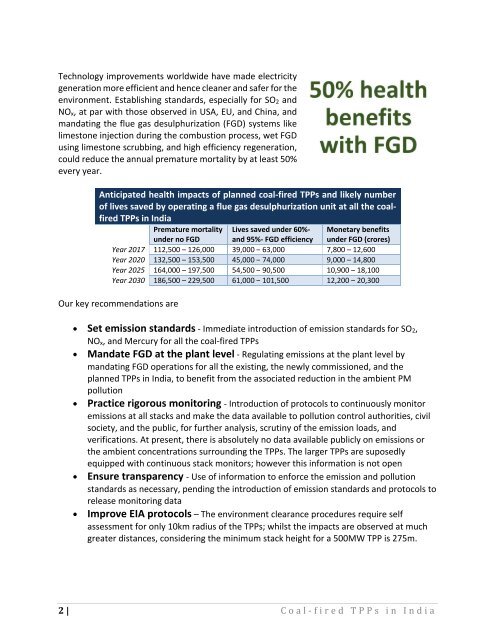Coal Kills
1TndvUf
1TndvUf
Create successful ePaper yourself
Turn your PDF publications into a flip-book with our unique Google optimized e-Paper software.
Technology improvements worldwide have made electricity<br />
generation more efficient and hence cleaner and safer for the<br />
environment. Establishing standards, especially for SO 2 and<br />
NO x , at par with those observed in USA, EU, and China, and<br />
mandating the flue gas desulphurization (FGD) systems like<br />
limestone injection during the combustion process, wet FGD<br />
using limestone scrubbing, and high efficiency regeneration,<br />
could reduce the annual premature mortality by at least 50%<br />
every year.<br />
Anticipated health impacts of planned coal-fired TPPs and likely number<br />
of lives saved by operating a flue gas desulphurization unit at all the coalfired<br />
TPPs in India<br />
Premature mortality<br />
under no FGD<br />
Lives saved under 60%-<br />
and 95%- FGD efficiency<br />
Monetary benefits<br />
under FGD (crores)<br />
Year 2017 112,500 – 126,000 39,000 – 63,000 7,800 – 12,600<br />
Year 2020 132,500 – 153,500 45,000 – 74,000 9,000 – 14,800<br />
Year 2025 164,000 – 197,500 54,500 – 90,500 10,900 – 18,100<br />
Year 2030 186,500 – 229,500 61,000 – 101,500 12,200 – 20,300<br />
Our key recommendations are<br />
• Set emission standards - Immediate introduction of emission standards for SO 2 ,<br />
NO x , and Mercury for all the coal-fired TPPs<br />
• Mandate FGD at the plant level - Regulating emissions at the plant level by<br />
mandating FGD operations for all the existing, the newly commissioned, and the<br />
planned TPPs in India, to benefit from the associated reduction in the ambient PM<br />
pollution<br />
• Practice rigorous monitoring - Introduction of protocols to continuously monitor<br />
emissions at all stacks and make the data available to pollution control authorities, civil<br />
society, and the public, for further analysis, scrutiny of the emission loads, and<br />
verifications. At present, there is absolutely no data available publicly on emissions or<br />
the ambient concentrations surrounding the TPPs. The larger TPPs are suposedly<br />
equipped with continuous stack monitors; however this information is not open<br />
• Ensure transparency - Use of information to enforce the emission and pollution<br />
standards as necessary, pending the introduction of emission standards and protocols to<br />
release monitoring data<br />
• Improve EIA protocols – The environment clearance procedures require self<br />
assessment for only 10km radius of the TPPs; whilst the impacts are observed at much<br />
greater distances, considering the minimum stack height for a 500MW TPP is 275m.<br />
2 | <strong>Coal</strong>-fired TPPs in India




